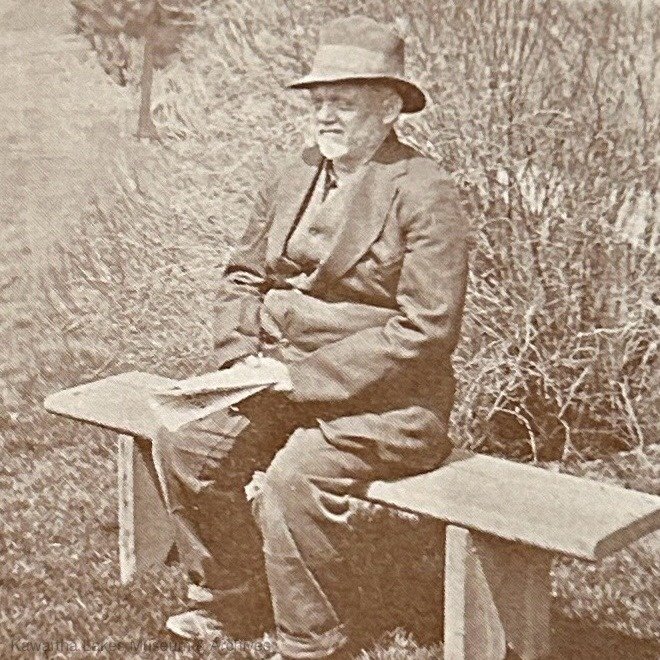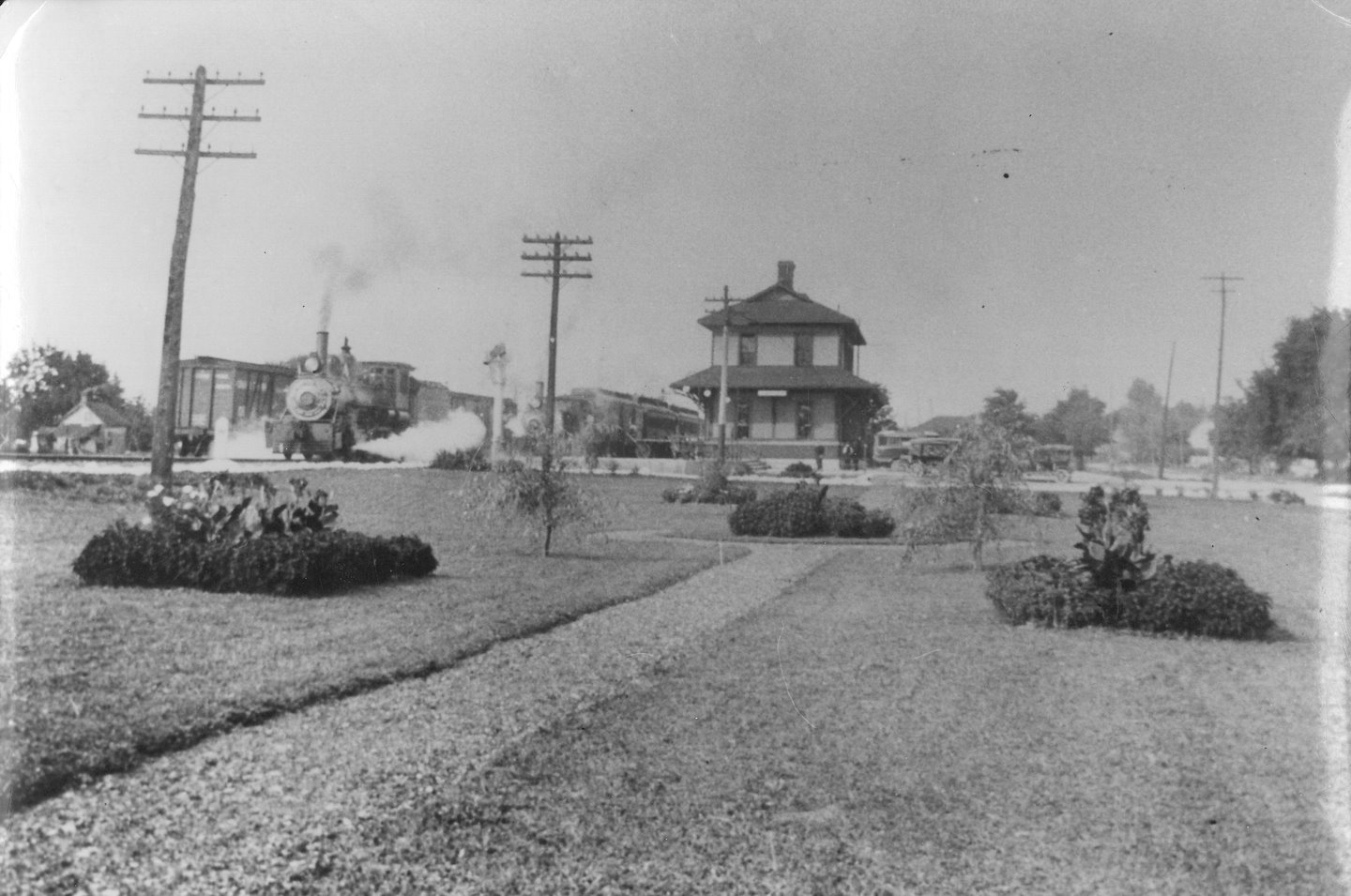Harmonies of Hardship: The Jasper Lacombe Story
Jasper Lacombe, a name synonymous with resilience and the enduring spirit of a community, left an indelible mark on the towns of Lindsay and Peterborough. His story, though tinged with hardship, reveals a man who was much more than the circumstances that often surrounded him.
Bernard “Jasper” Lacombe sitting on a bench. Photograph appeared in the 1924 Old Home Week booklet. Kawartha Lakes Museum & Archives.
Born to Edward Lacombe and Margaret Jane Brisbin on May 4, 1862, in Quebec, Jasper became a beloved and emblematic figure in his later years spent in Lindsay. Tragically, he passed away just eight days shy of his 73rd birthday from myocardial failure, following a bout of slight paralysis, at the residence of George and Carry Ellsworth at 15 Water Street in Lindsay on April 24, 1935. Mrs. Ellsworth, with whom he resided during his final years, reported his death to the authorities. Jasper, whose real name was posthumously revealed to be Bernard, had spent his formative years in Peterborough, where his exceptional talent on the tin flute made him a local spectacle. Every Saturday afternoon, he was the focal point at the marketplace, captivating audiences with tunes that resonated well beyond mere entertainment, acting as a bridge that connected him deeply with the community around him.
Jasper had two sisters, Elida (or Ida Martha) Lacombe and Mary Emma Lacombe. Tragically, Mary died of diphtheria in 1879, one year after their mother passed away from pulmonary consumption. Following these devastating losses, it seems that the family dispersed, with Jasper remaining in Peterborough.
Records appear to suggest that Jasper moved to Lindsay after 1899. He brought along his cherished flute and an intriguing method of lighting his pipe. Never using matches, Jasper opted for the sun’s rays and a large magnifying glass; a technique that fascinated locals and became one of his defining quirks. Known to always hang out on Kent Street, passersby would stop and watch him light his pipe, which Jasper found to be quicker than pulling out matches.
Grand Trunk Railway station on Durham Street, Lindsay. 1920. (1975.566.3). Kawartha Lakes Museum & Archives.
Despite his blindness, Jasper still lived his life with unique zest. Making some spare change, Jasper would sell newspapers—particularly the Toronto World and The Evening Post—to folks walking on Kent Street or while hanging out on the platform of the Grand Trunk Railway station on Durham Street. The sound of "Paa-purr" would be heard throughout the street when Jasper was making his rounds. It would seem that although he was never a bother to people, he was a nuisance to the authorities of the G.T.R. station. In 1904, the staff of the station barred him from selling newspapers on their property as they already employed a “news agent.” The station staff would also turn a blind eye towards the harassment and assaults that would occur to Jasper while he hung around the platform. In an incident on August 31, 1906, a group of Peterborough lacrosse team supporters, lifted their spirits after their team was defeated, by teasing and tormenting Jasper while waiting for the train to their hometown. The assailants got him on the platform and by shoving him around and bullying him, the crowd seemed to get amusement out of his despair. As he was blind and could not see from where his attackers were coming from, Jasper pulled a jackknife from his pocket and reportedly threatened the gang should they continue to attack. It was reported that the G.T.R. station authorities were slow to act and it can be presumed that they broke up the fight once Jasper decided to defend himself from torment and not when he was being assaulted initially.
This harassment was noted and seen by the Chief of Lindsay Police, Ralph Vincent, who thought this was unacceptable behaviour from the boys and girls of Lindsay and Peterborough. On June 6, 1907, two boys, George Barnes and Bert Hooper, were reportedly tormenting Jasper again and the Chief found them and arrested them for their behaviour. Both boys pleaded “guilty” and George Barnes was let off with a suspended sentence and a fine of $2.70, which he paid. Bert Hooper’s case, scheduled for June 17, was dismissed by Judge Alex Jackson.
George Barnes and Bert Hooper were arrested by Chief Vincent on June 6, 1907 on the charge of Breach of By-Law 1091. Kawartha Lakes Police Services fonds. Kawartha Lakes Museum & Archives.
The claim that Chief Vincent was at his wits' end with Jasper being harassed can be validated when consulting the Lindsay Police Court records in the archives. At the time of the assault/harassment of Jasper by Barnes and Hooper, Chief Vincent did not arrest them for that crime, but rather for “Breach of By-Law 1091,” which made it an offense to fire a firecracker(s) promiscuously within the Town of Lindsay. Chief Vincent probably did not witness the initial crime, but through witnesses found where the boys went and, in order to teach them a lesson, decided to charge them with a crime he witnessed them partake in when he found them.
House of Refuge, Lindsay, Ontario. 1906. Kawartha Lakes Museum & Archives.
Jasper lived precariously and seemed to never have a home that he owned or rented. Having no family in the area, there was no reliable comfort that he could fall back on. At one time, he received a handout of $1.40 per week from the Town’s “charity” allotment. As the Town would cut its charity budget in 1907, the council wanted Jasper to be put in the House of Refuge on Angeline Street South and receive an allowance through their budget. Jasper resisted any pressure to move to the Refuge and appeared to have the support of some businessmen. In June 1909, M. J. McGeough and B. J. Gough approached the Council with a deputation in which they asked them to increase Jasper’s allotment to match what the St. Vincent de Paul Society gave him. The Society had been paying Jasper’s board for the previous six months. Where Jasper was staying is not known at this point and it would appear that he did end up living in the House of Refuge in and after 1911.
As mentioned above, Jasper would die on April 24, 1935 at 15 Water Street in the care of George and Carry Ellsworth.
Transcript of his obituary that appeared in The Lindsay Post on April 27, 1935:
“Jasper Lacombe Familiar to Local Citizens and Travelling Public Lays Down Flute and Papers in Death | One of Lindsay’s character of past years was laid to rest this morning in the person of Jasper Lacombe whose correct name is said to be Bernard. He died on Wednesday after a short illness at the home of Mr. Ellsworth, 15 Water Street.
Bernard “Jasper” Lacombe’s death certificate. Note that his parents’ names on the death certificate are different than ones which appeared on census records.
He was born in Quebec and for years lived in Peterborough before coming to Lindsay thirty years ago. During his life in Peterborough he was well known for his prowess in obtaining music from a tin flute and on Saturday afternoons in the market place of that city was always the centre of a large crowd of listeners as he played the tunes of the day.
When he came to Lindsay he brought his tin flute with him and was a familiar figure at the old Grand Trunk station with a number of papers under one arm and his omnipresent flute in the other. Another practice of this well known old man was the habit of never using a match to light his stubby pipe when the sun was shining. He always carried a powerful magnifying glass in his pocket and when desiring a smoke would pull the glass cut and focus it on the tobacco in the pipe and with a little patience and steadiness would soon have his pipe smoking merrily.
He had been partially blind for years and up until recently was an inmate of the House of Refuge. Lately he lived with Mr. and Mrs. Ellsworth in town at whose home he died. He will be well remembered by ex-residents of the town and by the travelling public who were familiar with him during the years when he sold papers at the station.
He was an ardent Catholic and was a familiar figure at the church where he occupied the same pew for years. His funeral mass was sung by Rt. Rev. W. J. McColl, parish priest, and interment was made at St. Mary’s Cemetery.”
Written by Zac Miller, Archivist





